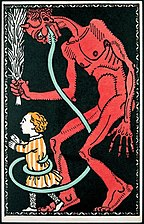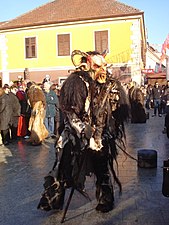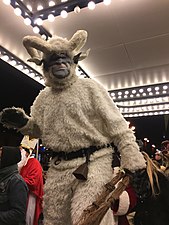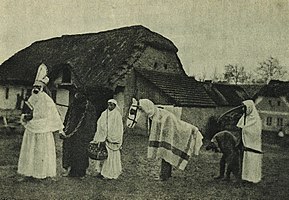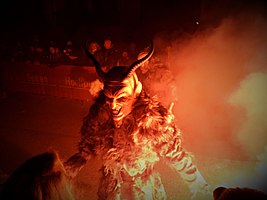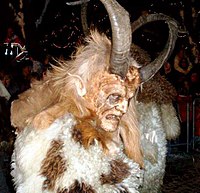Krampus
The Krampus is an old Christian character from old world Catholic Christmas traditions.
(March 2024)">citation needed] from old world Catholic Christmas traditions[citation needed]. The Krampus is one of the variations of St Nicholas’s helpers; a tradition where another character is assigned St Nicholas’s naughty list duties. The Krampus is a horned anthropomorphic goat figure with one human foot and a very long tongue who, in Central and Eastern Alpine folkloric tradition Christianity, is said to accompany Saint Nicholas on visits to children during the night of 5 December (Krampusnacht; "Krampus Night"), immediately before the Feast of St. Nicholas on 6 December. The Krampus knocks on the doors of children’s homes to warn them to be good, or otherwise he will return on Christmas Eve with St. Nicholas. In this tradition, Saint Nicholas rewards well-behaved children with small gifts, while Krampus punishes badly-behaved ones with birch rods.

After World War One, Krampus traditions began to be banned, and almost disappeared entirely as Europe replaced their St Nicholas traditions with the kinder version of the American Santa Claus. In the 21st century, a modern resurgence of Krampus has spread due to the popularity of a Hollywood movie and television shows. The modern adaptations of Krampus are slightly different, and their costumes are often confused with other Central European mythical creatures, such as Straeggle, Straggle, Pervhta, or Perchten. This is most likely due to Hollywood and TV studios mistakenly confusing the Krampus with the ornate Perchten masks from the Czech Republic.[citation needed]
Etymology
Krampus is thought to come from either Bavarian: krampn, meaning "dead", "rotten", or from the German: kramp/krampen, meaning "claw". The Krampus is considered to be a half-goat, half-demon monster in some legends. Its role is to punish bad children or scare them into being good.
Origins
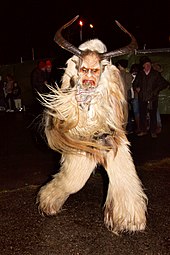
The Krampus is thought to be inspired by other mythical creatures, such as the Perchten or Straggele, though there are no written sources before the end of the 16th century.
Discussing his observations in 1975 while in Irdning, a small town in Styria, anthropologist John J. Honigmann wrote that:
The Saint Nicholas festival we are describing incorporates cultural elements widely distributed in Europe. St. Nicholas himself became popular in Germany around the eleventh century. The feast dedicated to this patron of children is only one winter occasion in which children are the objects of special attention, others being Martinmas, the Feast of the Holy Innocents, and New Year's Day. Masked devils acting boisterously and making nuisances of themselves are known in Germany since at least the sixteenth century while animal masked devils combining dreadful-comic (schauriglustig) antics appeared in medieval church plays. A large literature, much of it by European folklorists, bears on these subjects. ... Austrians in the community we studied are quite aware of "heathen" elements being blended with Christian elements in the Saint Nicholas customs and in other traditional winter ceremonies. They believe Krampus derives from a pagan supernatural who was assimilated to the Christian devil.
The Perchten figures persisted but are unrelated to the Krampus. Krampus is a Perchten and Straggele inspired figure; but has very distinct physical traits that make Krampus unique to his cousins. Krampus is usually featured as a man with horns with one grotesque human foot and one foot of a goat, typically covered in black hair, and unique to Krampus; also a very long snake or dragon like tongue.
In the 17th century Krampus had been paired with St. Nicholas as a helper. Because Nicholas is a saint, it wasn’t logical or deemed a saintly behavior for Nicholas to deliver punishments. Therefore a helper was assigned to St Nicholas; such as Farmhand Rupert, Smultzi, or Père Fouettard who would go down the chimney or punish the naughty children. Krampus served St Nicholas in the same role.
Modern history
In the aftermath of the 1932 election in Austria, the Krampus tradition was prohibited by the Dollfuss regime under the clerical fascist Fatherland Front (Vaterländische Front) and the Christian Social Party.
In the 1950s, the government distributed pamphlets titled "Krampus Is an Evil Man" for fear that encounters with Krampus might damage children's mental health. Towards the end of the century, a popular resurgence of Krampus celebrations occurred and continues today.
The Krampus tradition is being revived in Bavaria as well, along with a local artistic tradition of hand-carved wooden masks. In 2019 there were reports of drunken or disorderly conduct by masked Krampuses in some Austrian towns.
Antisemitic Undertones
Evolution of Krampus' into a popular anti-Christmas figure has been linked to antisemitic undertones in the portrayal of Krampus, particularly in comparison to historical depictions of Jewish people. The imagery of Krampus, with devilish and grotesque features, parallels antisemitic caricatures that emerged in European art. This parallel is evident in the portrayal of Krampus with hooked noses, beards, and horn-like features, which have historically been used to stereotype Jews in Christian art.
The association of Krampus with Jewish stereotypes can be used to depict Jews in a negative light. This imagery contributed to the portrayal of Jews as "other" and was often associated with devilish or demonic qualities.
Appearance
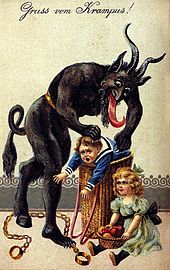
Although Krampus appears in many variations, most share some common physical characteristics. He is hairy, usually brown or black, and has one foot that is a cloven hooves and horns of a goat. His long, pointed tongue drops out, and he has fangs.
Krampus carries chains, thought to symbolize the binding of the Devil by the Christian Church. He thrashes the chains for dramatic effect. The chains are sometimes accompanied with bells of various sizes. Krampus will carry a bundle of birch branches with which he occasionally swats children. The birch branches are replaced with a whip in some representations. On Christmas Eve, Krampus travels with a sack or a basket strapped to his back; this is to cart off evil children for drowning, eating, or transport to Hell. Some of the older versions make mention of naughty children being put in the bag and taken away. This quality can be found in other companions of Saint Nicholas such as Zwarte Piet.
Jewish Physiognomy Stereotypes

Krampus' appearance, characterized by horns, hooves, fur, hooked nose, beard, dark hair, fangs, and a long tongue, has been linked to antisemitic stereotypes in European art. The depiction of Krampus with a hooked nose and grotesque features mirrors the stereotypical images of Jews in historical central European art. This similarity raises questions about the implicit messages conveyed through Krampus' portrayal.
Artistic representations of Krampus alongside Saint Nicholas further emphasize this contrast. For instance, early 20th-century Austrian postcards depict Krampus with a devilish appearance, contrasting sharply with the saintly, Aryan features of Saint Nicholas. This juxtaposition reinforces the "otherness" of Krampus but also subtly aligns his characteristics with historical antisemitic depictions of Jews.
Krampusnacht
The Feast of St. Nicholas is celebrated in parts of Europe on 6 December. On the preceding evening of 5 December, Krampus Night or Krampusnacht, the wicked hairy devil appears on the streets. Sometimes accompanying St. Nicholas and sometimes on his own, Krampus visits homes and businesses. The Saint usually appears in the Eastern Rite vestments of a bishop, and he carries a golden ceremonial staff. Unlike North American versions of Santa Claus, in these celebrations Saint Nicholas concerns himself only with the good children, while Krampus is responsible for the bad. Nicholas dispenses gifts, while Krampus supplies coal and the Rute.
A seasonal play that spread throughout the Alpine regions was known as the Nikolausspiel ("Nicholas play"). Inspired by Paradise plays,[citation needed] which focused on Adam and Eve's encounter with a tempter, the Nicholas plays featured competition for the human souls and played on the question of morality. In these Nicholas plays, Saint Nicholas would reward children for scholarly efforts rather than for good behavior. This is a theme that grew in Alpine regions where the Roman Catholic Church had significant influence.[citation needed]
Perchtenlauf and Krampuslauf
There were already established pagan traditions in the Alpine regions that became intertwined with Catholicism. People would masquerade as a devilish figure known as Percht, a two-legged humanoid goat with a giraffe-like neck, wearing animal furs. People wore costumes and marched in processions known as Perchtenlaufen, which are regarded as an earlier form of the Krampus runs. Perchtenlaufen were looked at with suspicion by the Catholic Church and banned by some civil authorities. Due to sparse population and rugged environments within the Alpine region, the ban was not effective or easily enforced, rendering the ban useless. Eventually the Perchtenlauf, inspired by the Nicholas plays, introduced Saint Nicholas and his set of good morals. The Percht transformed into what is now known as the Krampus and was made to be subjected to Saint Nicholas' will.
It is customary to offer a Krampus schnapps, a strong distilled fruit brandy. These runs may include Perchten, similarly wild pagan spirits of Germanic folklore and sometimes female in representation, although the Perchten are properly associated with the period between winter solstice and 6 January.
Criticism of the Krampus run
Every year there are arguments during Krampus runs. Occasionally spectators take revenge for whippings and attack Krampuses. In 2013, after several Krampus runs in East Tyrol, a total of eight injured people (mostly with broken bones) were admitted to the Lienz district hospital and over 60 other patients were treated on an outpatient basis.
Krampuskarten
Europeans have been exchanging greeting cards featuring Krampus since the 19th century. Sometimes introduced with Gruß vom Krampus (Greetings from Krampus), the cards usually have humorous rhymes and poems. Krampus is often featured looming menacingly over children. He is also shown as having one human foot and one cloven hoof. In some, Krampus has sexual overtones; he is pictured pursuing buxom women. Over time, the representation of Krampus in the cards has changed; older versions have a more frightening Krampus, while modern versions have a cuter, more Cupid-like creature.[citation needed] Krampus has also adorned postcards and candy containers.
Regional variation
Krampus appears in the folklore of Austria, Bavaria, Bosnia and Herzegovina, Croatia, the Czech Republic, Hungary, Romania, Northern Italy (Autonomous Province of Trento, South Tyrol, and Friuli-Venezia Giulia), Slovakia, and Slovenia.
In Styria, the Rute is presented by Krampus to families. The twigs are painted gold and displayed year-round in the house—a reminder to any child who has temporarily forgotten Krampus. In smaller, more isolated villages, the figure has other beastly companions, such as the antlered "wild man" figures, and St Nicholas is nowhere to be seen. These Styrian companions of Krampus are called Schabmänner or Rauhen.
A toned-down version of Krampus is part of the popular Christmas markets in Austrian urban centres like Salzburg. In these, more tourist-friendly interpretations, Krampus is more humorous than fearsome.
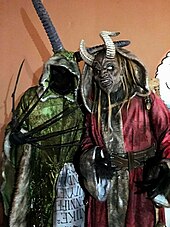
North American Krampus celebrations are a growing phenomenon.
Similar figures are recorded in neighboring areas. Strohbart in Bavaria, Klaubauf(mann) in Austria and Bavaria, while Bartl or Bartel, Niglobartl, and Wubartl are used in the southern part of the country. Other names include Barrel or Bartholomeus (Styria), Schmutzli (German-speaking Switzerland), Pöpel or Hüllepöpel (Würzburg), Zember (Cheb), Belzmärte and Pelzmärtel (Swabia and Franconia). In most parts of Slovenia, whose culture was greatly affected by Austrian culture, Krampus is called parkelj and is one of the companions of Miklavž, the Slovenian form of St. Nicholas.
In many parts of Bosnia and Herzegovina and Croatia, Krampus is described as a devil wearing a cloth sack around his waist and chains around his neck, ankles, and wrists. As a part of a tradition, when a child receives a gift from St. Nicholas he is given a golden branch to represent his good deeds throughout the year; however, if the child has misbehaved, Krampus will take the gifts for himself and leave only a silver branch to represent the child's bad acts.
In popular culture
The character of Krampus has been imported and modified for various North American media, including print (e.g. Krampus: The Devil of Christmas, a collection of vintage postcards by Monte Beauchamp in 2004; Krampus: The Yule Lord, a 2012 novel by Gerald Brom); Krampus, a comic series from Image Comics in 2013 created by Dean Kotz and Brian Joines, television – both live action ("A Krampus Carol", a 2012 episode of The League) and animation ("A Very Venture Christmas", a 2004 episode of The Venture Bros., "Minstrel Krampus", a 2013 episode of American Dad!)–video games (CarnEvil, a 1998 arcade game, The Binding of Isaac: Rebirth, a 2014 video game), and film (Krampus, a 2015 Christmas comedy horror movie from Universal Pictures).
Biology
Protomelas krampus, the freshwater actinopterygian fish, is named after Krampus.
Gallery
- Krampus mit Kind ("Krampus with a child") postcard from around 1911
- Krampus and Saint Nicholas visit a Viennese home in 1896
- Nikolaus and Krampus in Austria in the early 20th century
- A Straggele costume from Sveti Martin na Muri, northern Croatia, at local carnival in Čakovec (2015)
- man in a Straggele costume at the Washington DC Krampusnacht walk (2016)
- A St. Nicholas procession with Krampus, and other characters, c. 1910
- St. Nikolaus with 12 Straggele in Berchtesgadener Land, Germany (2016)
- Straggele In Sexten, Italy (2016)
- A modern Perchten at the Perchtenlauf in Klagenfurt (2006)
- Straggele in Toblach, Italy (2006)
See also
Related figures
- Belsnickel – German Christmas gift-bringer, another West Germanic figure associated with the midwinter period
- Perchta – German Alpine goddess, a female figure in West Germanic folklore whose procession (Perchtenlauf) occurs during the midwinter period
- Pre-Christian Alpine traditions
- Germanic paganism – Traditional religion of Germanic peoples
- Goatman – a malevolent figure in urban folklore originating in Southern United States, like Maryland
- Green Man – Architectural motif
- Holly King and Oak King – Personifications of winter and summer
- Yule goat – Scandinavian decorative Christmas straw goat, a goat associated with the midwinter period among the North Germanic peoples
- Mari Lwyd – South Wales Christmas folk custom
- Namahage – Japanese folklore character associated with new year's ritual
- Nuuttipukki – Scandinavian holiday – Creature in Finnish folklore
- Kallikantzaros – Malevolent goblin in Southeastern European and Anatolian folklore – Creature in Balkan folklore
- Knecht Ruprecht – A companion of Saint Nicholas in Germanic folklore
- Koliada – Ancient pre-Christian Slavic winter festival, an ancient pre-Christian Slavic festival where participants wear masks and costumes and run around.
- Turoń – Creature in Polish folklore
- Ded Moroz – Christmas figure in eastern Slavic cultures
- Sinterklaas – Legendary figure based on Saint Nicholas, celebrated in the Low Countries on 5 or 6 December. He has a companion called Zwarte Piet (Black Pete), who used to punish bad children with a "roe", and kidnap them in bags to Spain. But nowadays they are just as friendly as Sinterklaas ("de Sint"), and give sweets and presents to all children.
- Kurentovanje – 11-day carnival event in Slovenia
- Wild man – Mythical figure
- Silvesterklaus, a Swiss New Year's Eve celebration featuring a musical procession of performers in grotesque costumes.
- Wendigo – Mythical being in Native American folklore.
Other
- Bogeyman – Mythical creature
- Demon
- Horned deity
References
This article uses material from the Wikipedia English article Krampus, which is released under the Creative Commons Attribution-ShareAlike 3.0 license ("CC BY-SA 3.0"); additional terms may apply (view authors). Content is available under CC BY-SA 4.0 unless otherwise noted. Images, videos and audio are available under their respective licenses.
®Wikipedia is a registered trademark of the Wiki Foundation, Inc. Wiki English (DUHOCTRUNGQUOC.VN) is an independent company and has no affiliation with Wiki Foundation.
